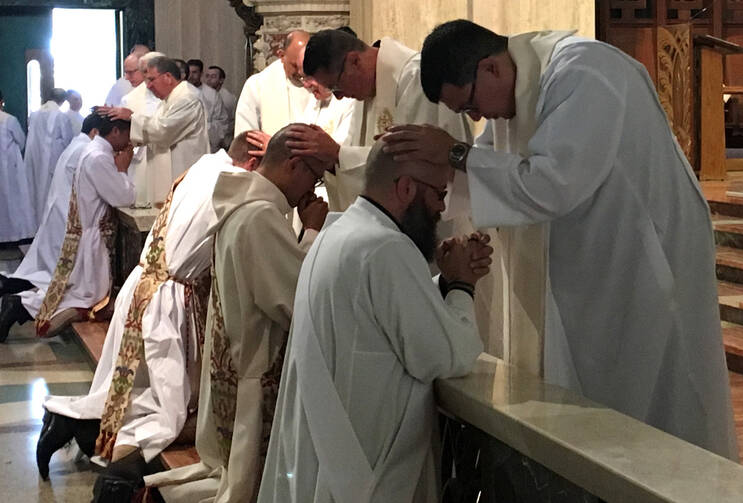If you were to be a fly on the wall at any meal at any Jesuit community in the United States over the last six years, you would almost certainly hear at least a grumble, if not a swipe, a snort or a highly entertaining rant about “province realignment.” For what seems like forever now (but is actually about 10 years), the Jesuits of the United States have been moving toward the merger of their 10 provinces into four larger units covering the West Coast, the East Coast, the Midwest and the South.
As you might imagine, it has been a sometimes uneasy process. Though U.S. Jesuits have been trained with other men from across the country and around the world for decades, every province has its own culture, history and priorities. In the California province, as the joke goes, it takes 12 people to change a lightbulb, one to turn the bulb and 11 to arrange the fantastic dinner party to follow; in Wisconsin it takes four, one to change the current bulb and three to tell nostalgic stories about past bulbs; and in New York it only takes one because Jesus Christ, this is %!#%! New York, get over yourself already.
“It doesn’t really matter to us where the ordination is. But could we have a bishop who can speak to the immigrant experience?”
Having provinces merge means potentially losing some of that culture, having longstanding priorities challenged and sometimes changed. Also, while part of the thinking was fewer provinces could mean less duplication of effort on province offices, freeing up talented men, for now province staffs are larger than they have ever been as they each contend with managing dozens of institutions, hundreds more Jesuits and areas almost the length or width of the entire country.
Suffice to say, the consolidation is a work in progress. The brethren have mixed feelings about it, and their provincials know it.
“All of us provincials who are forming these new provinces are feeling the delicate dance between what you do in [the former territory of] one province and what you do in the other,” says Scott Santarosa, S.J., who as of July 1 will move from being provincial of the Oregon Province to provincial of the combined Oregon-California province now known as “Jesuits West.” Where to hold major community celebrations like the yearly ordinations, what traditions to take from each province: “These are kind of no-win situations.”
But as Father Santarosa looked forward to the 2018 ordinations, the first for the newly merged province, one of the men to be ordained helped reframe the question. An immigrant to the United States, as are two of his classmates, he told Father Santarosa, “It doesn’t really matter to us where the ordination is. But could we have a bishop who can speak to the immigrant experience?”
That got Father Santarosa and his formation director, Glen Butterworth, S.J., thinking. “Instead of presuming smallness on the part of Jesuits, each province trying to figure out how to get the leg up on the other, what if we presume largeness of heart? What can the ordination really mean?”
With that, they threw out all the usual, easy models—the Jesuit university or parish, the cathedral in a town with a lot of Jesuits—and decided instead to have the ordination at Our Lady of Mt. Carmel in San Ysidro, Calif., an ordinary diocesan parish a mile and a half from Mexico. From its parking lot you can actually see the border; diocesan prayer services regarding immigration are often held there. Local ordinary Bishop Robert McElroy will perform the ceremony, and Father Santarosa sees the ordination as an opportunity to raise a flag that might inspire this new province.
“I think it’s a way of saying to everybody, we can use these events, which are dear to us, to say something about who we are, who we are going to be and who we stand with,” he said. “And a significant number of our men in formation are immigrants, not just from south of the border but from Asia and other parts of the world.”
One of the most striking elements of the papacy of Francis has been his awareness of the power of public moments. Often with as little as a pat on the cheek or a tousle of the hair, he has spoken volumes about not just his own care for people but the care that God has and what it means to be church. Again and again he has demonstrated how a simple, public act of kindness, of being-with can cut through divisions and jargon to express meaningful and challenging realities of our faith.
The question, of course, is how that trickles (or hopefully, cascades) down. In light of Francis, how do pastors, prelates, presidents, principals, hospital administrators and other figures in the church approach their own public ministry? Repositioning and imagining an ordination ceremony is one creative idea. What experiments or improvisations are other people attempting?
In the end, it is probably less about imitating the pope’s actions than adopting his approach: being present in the moment to the people around us, reaching out and listening.











Do each of the four Provinces have their own Novitiate ?
If so why ?
Why not one national Noviciate with the best possible Novice Master
and Socii ?
Are there still three centers for studying Philosophy ?
Why ?
Why not one national one ?
Are there still two Houses of Theology ?
Why ?
Why not one ?
Fr, McDermott S.J.,
In your introductory paragraph you have New York Jesuits
using the Lord's name in vain followed by swearing/cursing ?
Why ?
How does this denigration of the name of our Saviour
do anyone any good ?